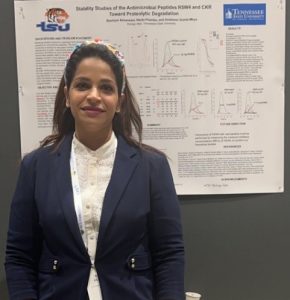Dr. Bashiyar Almarwani
Department of Biology
Tennessee State University

My research journey has been deeply rooted in addressing some of the most pressing challenges in infectious diseases and neurodegenerative disorders. The alarming rise of drug-resistant bacteria has underscored the urgent need for novel antimicrobial agents, while the global prevalence of neurodegenerative diseases highlights the demand for effective drug delivery systems. My work focuses on developing therapeutic agents that combat bacterial resistance without damaging host cells, thereby paving the way for safer and more efficient treatments. Using biophysical and spectroscopic techniques, I have analyzed the interactions between antimicrobial peptides (AMPs), cell-penetrating peptides (CPPs), and vesicles mimicking bacterial and mammalian membranes. By measuring minimum inhibitory concentration (MIC) values, I identified AMPs with ultralow MICs against WHO-designated priority pathogens, demonstrating their remarkable potential as substitutes for conventional antimicrobials. Additionally, I designed an innovative template based on RWn units to develop new antimicrobial agents and explored the threshold concentrations that enable direct translocation of CPPs like Pep-1 and penetratin. My current research is centered on understanding how lipid composition influences CPP internalization across membranes and investigating the synergistic effects of synthetic AMPs from the (RW)n series with traditional antibiotics. Through these efforts, I aim to contribute to the development of groundbreaking therapeutic agents and drug delivery systems that address bacterial resistance and enhance clinical outcomes. I utilized Raman microscopy and scanning electron microscopy at the VINSE lab. I employed Raman spectroscopy to investigate the localization and insertion of PEN within the lipid bilayer. Scanning electron microscopy (SEM) to visualize the effect of the peptide addition or adsorption to the lipid layer or cell wall.
My research has relied extensively on the facilities at VINSE, including the analytical laboratory and advanced imaging facility, which have enabled me to conduct cutting-edge scientific investigations. One of the most fulfilling aspects of being part of VINSE is the strong sense of community it cultivates. I am deeply grateful to VINSE and its exceptional staff for their invaluable support throughout my research journey.
Contact Dr. Almarwani: balmarwa@tnstate.edu